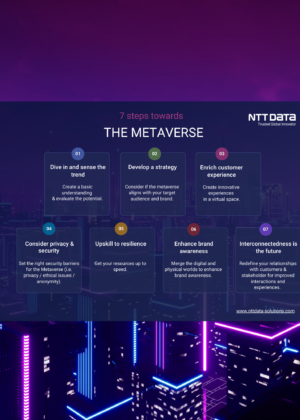Advancements in technology demand our attention, whether we are ready to embrace them or not.
The metaverse is a vision of the immersive future of the internet. The concept is developing fast, as is the set of technologies that will underpin it. While its integration into society-wide daily life may still be some way off, plenty of early adopters are already laying the foundations for their brands, businesses and enterprises to reap the potential rewards further down the line.
The opportunities are vast and varied, with elements of the metaverse such as cryptocurrency and NFTs already familiar to many internet users. There is huge potential for the metaverse to fundamentally change how businesses and consumers interact.
As with all fast-moving tech, there will also be downsides and metaverse threats that need to be protected against. Will the metaverse ever ultimately be ‘worth it’ for business? Could meeting in the metaverse ever offer advantages over meeting in real life? This article addresses some most-asked questions to help strip away the noise and offer a balanced overview.
- What is the metaverse?
- How does the metaverse work?
- Who owns the metaverse?
- What types of metaverse platforms are there?
- Where is the difference between the metaverse and virtual reality?
- What does a company need to get started in the metaverse?
The Opportunities of the Metaverse
By 2026, it is expected that 25% of people will spend at least one hour per day in the metaverse for the purposes of work, shopping, education, social media, and/or entertainment, according to Gartner.
Such a fundamental shift in consumer behaviour means a wide range of exciting possibilities are set to open up for businesses, as business-customer interaction and the products and services on offer evolve.
- What are the key innovation areas in the metaverse?
- Why should businesses be mindful of the metaverse – and why now, when it’s still so far away?
- Who is already active in the metaverse?
The Risks of the Metaverse and How They Can Be Mitigated
As with all rapidly-developing new technology, the metaverse brings new challenges and a number of risks due to new experiences and enhanced digital identities. These challenges are further complicated by the decentralised nature of the metaverse.
- What are the metaverse risks?
- How can a business entering the metaverse mitigate the risks?
- NFTs: are they a scam?
Summing Up: Why Is Now the Right Time to Start Thinking About the Metaverse?
Earlier in the article, we explored predictions about the rapidly rising use of the metaverse among private and commercial users. The time frame for these changes is not on the scale of decades, but the next three or four years, and Gartner has already identified the metaverse as one of the top ten strategic technology trends for 2023.
Bloomberg, for its part, has valued the metaverse as an $800 billion market opportunity, while awareness and education levels around the metaverse is fast increasing among consumers. With its own virtual economy and social responsibility requirements, the metaverse will require participating businesses to devise a strategic approach to entering and exerting ownership over the digital extension of their own brand in this unique space. Keeping abreast of changes now may prove beneficial in the future.
Metaverse FAQs
The term metaverse comes from “meta” (derived from the Greek word for beyond) and “verse” from universe.
The metaverse is a virtual, shared space that provides interactive and social functionalities. Inhabited by humans in the form of digital avatars, it is a space where users can do or experience things with others in an immersive way that gives a feeling of presence. It’s like being right there with another person, breathing the same air and having real-life experiences.
Think about the metaverse as the next generation of the internet – a concept that encompasses the transition into three-dimensional online environments. This immersive internet experience is realised through a combination of Web 3.0, virtual reality (VR), augmented reality (AR), blockchain technology and more.
The metaverse requires multiple technologies – both established and emerging – to function. It is a space where physical and digital realities converge to create a virtual world that parallels real life.
Digital currency plays a central role in the metaverse, as it forms part of the digital economy upon which all kinds of trades can be made. Non-fungible tokens (NFTs) are another form of transaction that make up an independent virtual economy in the virtual space.
Tech trends in the spatial computing realm, such as VR, AR and artificial intelligence (AI), come together to help form the infrastructure of the metaverse, allowing complex interactions between the various elements to take place.
No single entity owns the metaverse. By the very nature of the metaverse – as a decentralised network of virtual spaces – it cannot be owned by a sole entity. Rather, the metaverse has been – and continues to be – created by a vast array of creators, developers, artists, investors and users. Each user owns their own data and digital assets.
That said, some stakeholders in the metaverse are bigger than others. These include those who have already begun to create their own virtual worlds or metaverse ecosystems within the wider organism.
There are two main types of metaverse platforms.
There are those that do not integrate blockchain in their mechanism and which operate on a centralised system, such as Roblox.
Then there are those platforms which do integrate blockchain and which use NFTs and cryptocurrencies. These can be either decentralised, such as Decentraland and The Sandbox, or centralised, like Meta (formerly Facebook). Roblox, Decentraland, The Sandbox and Meta are all examples of metaverse worlds that currently exist and are increasingly widely used.
The main differentiators lie in the definition and ownership of both.
As we’ve already learned, the metaverse is an immersive virtual space where users can engage in experiences with others while represented by their digital avatars. By contrast, VR is the actual technology for creating three-dimensional environments with elements of sight, touch and sound.
The metaverse is a permanent virtual world offering a wide range of experiences. The networks that comprise it continue to exist even when the user ceases to engage with them. However, the VR experience stops when the VR device being used is switched off. In addition, the user is limited to the virtual experiences offered in VR systems.
The second major difference is in regard to ownership. As already mentioned, the metaverse is not owned by any one individual or entity. A VR system, on the other hand, is owned by the brand which develops and produces it.
Dedicating resources within your company to understanding how the various components of the metaverse function and interact is a good first step towards preparing for entry into this virtual space.
There is an opportunity to reinvent a brand or company’s place in the physical world, through the consideration of which technologies – such as VR, AR and digital assets – are best suited to closing gaps, both internal and external. Consideration needs to be given to the question of whether the metaverse even aligns with your target audience and brand.
Once this base knowledge has been developed, a specific strategy can be formulated which focuses on identifying long-term metaverse opportunities for building within the space. The right social platform for entry, the relevance of particular areas of the metaverse to your business goals and your customers’ habits and preferences will all have an influence.
A focus on building consumer trust around the perceived metaverse risks – more on which can be found below – is another essential foundational aspect, as is ensuring a coherent brand experience for your customers across their metaverse and real-world interactions with your business.
Do you have a plan to the metaverse? We’ve gathered 7 simple steps to get you started on your journey to the Metaverse. Download our infographic.
The consumer metaverse brings with it huge potential, and the groundwork is already being laid for a social and fully immersive space for brands to serve their customers.
For brands who have already taken their first steps into the metaverse, hybrid shopping experiences, mixed reality and social gathering, gamification and immersive content have all proven to help influence and shape consumer behaviour.
On a commercial level, some businesses are already developing strategies to ensure their products and services become foundational to the operation of the metaverse. Microsoft is already positioning its cloud services as a metaverse-essential tool, with its Mesh platform being integrated into well-established products such as Teams.
There are internal benefits too. Human Resources processes are also being rapidly redefined, with onboarding in the metaverse providing a more immersive experience when it comes to attracting and retaining top talent. A richer learning and networking environment helps to offer an improved and more engaging journey for talent.
Key metaverse concepts such as cryptocurrency and NFTs are already highly relevant in the business and leisure space today. These continue to evolve as technology trends and to redefine how companies will operate internally and in the B2C context.
The industrial metaverse is another exciting prospect for businesses. It has the potential to harness AI to help design, build, operate and optimise physical systems using digital technologies.
Why should businesses be mindful of the metaverse – and why now, when it’s still so far away?
The metaverse is an “evolution, not a revolution”. The move towards mass acceptance and adoption of the metaverse will be a gradual process, but it is one that has undeniably already begun. By 2027, Gartner expects that over 40% of large organisations worldwide will be using a combination of Web 3.0, spatial computing and digital twins in metaverse-based projects aimed at increasing revenue. Businesses that want to maximise their own potential in the metaverse have an opportunity to stake an early claim.
The new technology being used and the paradigm shift from Web 2.0 to Web 3.0 pose challenges, but also – as mentioned above – bring big opportunities for companies to innovate. As consumers become increasingly savvy around the metaverse, they will naturally expect to be able to replicate their real-life interactions and experiences in the virtual space, and this is where the opportunity lies for businesses to contribute to this exciting shift.
Proof of the concept is well underway. Nike has patented metaverse products, and a host of other high-profile brands and organisations are actively identifying, developing and investing in metaverse opportunities.
As well as opening a metaverse concept store, ‘Vault’, on the Sandbox, Italian luxury brand Gucci has indicated its own confidence in a virtual future by establishing a new division, Metaverse Ventures, to expand its metaverse strategies.
Disney is another major brand with grand plans and big intentions. The formation of a Next Generation Storytelling and Consumer Experiences unit, including plans for a metaverse theme park experience, is yet another indicator of how mega-corporations view the direction of travel.
It isn’t just brands who see the potential. Underlining the potential of the metaverse as an extension of real-life experiences, Barbados signed an agreement in 2021 to open a digital embassy in Decentraland. And with colleagues, friends and family more likely than ever to be separated by space and short on time, the metaverse offers exciting, immersive ways of connecting and collaborating.
Find more examples of metaverse business use cases across several industries in part 1 of our metaverse blog article series.
The vision of the metaverse is that it will be fully decentralised. Because of this, there is still a long way to go with regards to governance, regulatory frameworks and implementation. Meaningful and productive debate around the moral, ethical and regulatory issues at the heart of the metaverse need to happen all at the same time.
Security risks faced by companies include issues around data collection and user privacy, cybersecurity, and harassment and assault, including that enabled by the misuse of haptic technologies.
There is also a potential issue around the widening of the digital divide, which may be exacerbated by certain hardware being required for full experiential access. The threats of social engineering and manipulated narratives will also need to be carefully navigated. Further threats are posed by the emergence of the darkverse, which, much like the dark web, is already being exploited by criminals and malicious actors taking advantage of a lack of legal authority in the space.
Meanwhile, the digital economy is vulnerable to financial malfeasance, with the expanding volume of e-commerce transactions expected to attract an increasing number of fraudsters.
How can a business entering the metaverse mitigate the risks?
Businesses will have a moral and ethical responsibility to help develop metaverse safeguards for their customers and to lobby for regulatory action in the space.
When it comes to protecting themselves from potential metaverse threats, there are a series of actions that can be taken by leaders and decision makers for their businesses.
Reputation protection through the establishment of frameworks such as data, security and privacy governance and policies will safeguard the interests of both businesses and consumers.
Carrying out due diligence on rights around Intellectual Property (IP) for digital assets such as NFTs, ensuring that your business and its digital assets are fully compliant with the service terms of the metaverse platform you are choosing to use, and devising metaverse-specific risk frameworks as part of company policy with expert input are all steps that can be taken to ensure you are well prepared.
NFTs: are they a scam?
Non-fungible tokens, more commonly referred to as NFTs, are the foundation blocks of value in the metaverse. They are unique data units stored in a blockchain and which can be sold and traded.
NFTs take many forms, including but not limited to graphic artwork, videos, collectibles, avatars, fashion items and music.
Like all (physical and digital) tradable assets, NFTs are susceptible to fraud. However, while any transaction or asset can be subject to scams and manipulations, NFTs carry an additional risk due to the current lack of regulation and established best practice.










